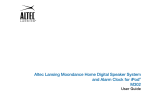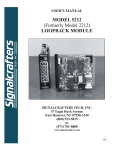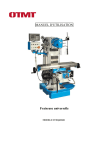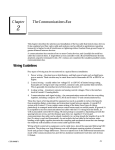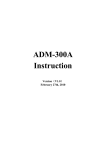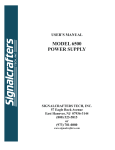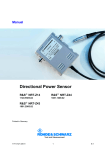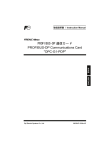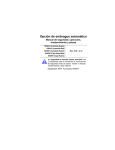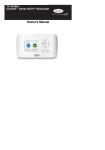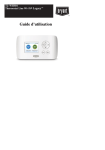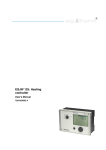Download Manual - Signalcrafters Tech Inc.
Transcript
USER’S MANUAL MODEL 2109 STATUS ENCODER SIGNALCRAFTERS TECH, INC. 57 Eagle Rock Avenue East Hanover, NJ 07936-3144 (800) 523-5815 or (973) 781-0880 www.signalcrafters.com Model 2109 Status Encoder Table of Contents Section Title 1 2 3 4 5 6 7 8 9 10 11 12 13 14 General, Functional Inspection Mounting Installer Connections Set-Up Testing Specifications Options Warranty Circuit Description Parts List Outline Drawings PC Board Assemblies Schematics 1. Page 1 4 4 5 8 16 18 21 21 21 24 27 28 33 GENERAL, FUNCTIONAL 1.1 This manual provides circuit description, installation procedures, basic testing information, and parts list for the Model 2109 Status Encoder. 1.2 The 2109 is a Wescom 400 – Tellabs Type 10 compatible card which is capable of simultaneously monitoring up to twelve inputs. It also provides a single relay control output – which may be expanded to a total of 65 with the addition of multiple relay expansion cards (2450, 2451, 2452). The 2109 contains both a DTMF encoder and decoder. 1.3 The twelve status inputs are optically isolated current sensors. Each input is dipswitch settable as N.O. (an alarm turns current ON) or N.C. (an alarm turns current OFF), and dip-switch settable to cause an alarm or not. To monitor dry contacts, connect each input in series with its contact and a source voltage – normally the source powering the 2109. 1.4 The 2109 may be used in either polling or self-initiate systems (change of state). The integrity of low activity self-initiate systems can be verified via a built-in 1 to 99 hour report timer, settable from the master station. 1.5 The 2109 is intended for use over virtually any voice-grade audio path including leased phone lines, cellular radio, UHF/VHF radio, or microwave. PSTN dial-up and cellular circuits may also be used with the addition of an FCC registered coupler and setting the appropriate dip-switches. 1.6 Typical applications for the 2109 fall into two general categories: 2 1. Reporting to a Model 2000 PC Master or Model 2106/2107 Base Master driving a Model 2401A printer. 2. Working in combination with another remotely located 2109 programmed as a complementary ACK/NAK pair, for SCADA extension. 1.7 The 2109 is the core product of the Lucas Ledex Sub-SCADA systems. The 2109 is DTMF code compatible with the following Lucas Ledex equipment: 2450, 2451, 2452 (and older 2212R) Relay Expanders 2110 Analog Encoder and 2110E Analog Expander Older Status Encoders 2104 and 2108 2211 and 2204 Controllers 1.8 Encoder Functional Description 1.81 For Interrogate Mode Only, set dip-switch 2 to ON. Paragraph 1.8x descriptions apply only to the 2109 programmed for both Self-Initiate and Interrogate Mode (mode dipswitches 2, 3 and 4 OPEN): 1.82 STACK OPERATION – The 2109 incorporates a 7 level stack (buffer) which stores data until it can be transmitted. Each level contains Alarm/Status information for all 12 inputs. Operation of the stack is first in, first out. Therefore, multiple sequential input changes will be transmitted in the order that they occurred. If the stack fills up in a highly active system, new data will be discarded, preserving those changes which started the sequence of events; yet upon “catching up,” the encoder will send the most recent data. With dip-switch 3 ON (ACK/NAK), the stack is only 2 levels. 1.83 C.O.R. OPERATION – This opto-coupled input inhibits DTMF transmissions while active. Data on the stack and subsequent changes will be saved and transmitted when C.O.R. is released. C.O.R. (carrier operated relay) logic is provided by a companion radio receiver. The C.O.R. may be programmed for N.O. or N.C. operation. 1.84 MULTIPLE SEND OPERATION – If s stem requirements are such that multiple sends are required, changes will be put on the stack and transmitted at the next send interval. If no changes occur between sends, the encoder will transmit the present status. 1.85 OPTO-COUPLER SCANNING – In normal operation all 12 opto-coupler inputs are scanned for a change of state. If a change occurs and remains changed for the recognition time, it will be acknowledged. Recognition times are program wire programmable for 100, 200, 400 or 800 milliseconds. If the input reverts back to its original state before recognition time, it will be ignored. A qualified change of state causes transmission of a DTMF burst containing the status of all 12 inputs. These conditions will inhibit immediate transmission: a. b. c. d. e. Mode dipswitches 2, 3 or 4 ON. There is data on the stack (buffer) which must be sent first. C.O.R. (Carrier Operated Relay) Inhibit is active. Unit is decoding incoming DTMF (interrogation, control relay command, etc.) The encoder has been configured fir MULTIPLE SEND operation and is in the ‘wait period’ between transmissions. 3 1.9 DECODER FUNCTIONAL DESCRIPTION – The following functions are remotely controlled via DTMF. 1.91 INTERROGATION – To interrogate a 2109 programmed for address 1001, send: 1 0 0 1 #. It will then transmit Alarm/Status data for its 12 inputs. 1.92 CONTROL RELAYS – If mode dip-switch 3 is OPEN, the 2109’s control relay (K2) provides 2 form-C contacts, which can be latched on; or pulsed on for 100 milliseconds, then off. The 2109 will echo the DTMF command, confirming the audio path. Optional relay card(s) can be added to provide up to 64 additional relays. The relay command is a six digit DTMF string: four address digits, one function digit, and one digit specifying the relay. Function * latches it on; # pulses it on, then latches it off. DTMF 1 thru 8 represent relays 1 through 8 on the optional relay cards; either 0 or 9 represents K2 on the 2109; “A” represents all 9 relays. At site 1001: DTMF 1001*1 1001*2 1001*0 1001#A 1001#9 1001#1 Action relay card K1 latches on relay card K2 latches on 2109 K2 latches on relay card K1 thru K8 and 2109 K2 pulse on for 100 ms, then latch off 2109 K2 pulses on for 100 milliseconds relay card K1 pulses on for 100 milliseconds To control more than one relay card, program the fourth (yellow) address wire to DTMF * (see paragraph 5.331). If mode dip-switch 3 is ON, the slave card relays are controlled by a companion 2109 after an exchange of several messages (ACK/NAK mode). This is often used to extend the contact inputs and control outputs of a SCADA system. ACK/NAK (verify before execute) systems use a pair of 2109’s slaved to each other monitoring contact closures at one location and replicating them at the other. Relay card(s) automatically follow the inputs of the companion 2109. Operation involves a sequence of automatically exchanged messages for use in critical control operations (more on ACK/NAK in paragraph 5.332). 1.93 REPORT TIMER – The 2109 can send an automatic status report at a programmed time interval. Intervals from 1 to 99 hours can be selected (in 1 hour increments). Both the time until first send and the interval between sends are programmable. This is a step operation. 1.931 The following examples show how the report timer is programmed. To activate the report timer 3 hours from now, with a repeat interval of 6 hours, 1.) Send the DTMF string: 1 0 0 1 D 0 6. The remote 2109 at site 1001 echoes the same string, indicating that a 6 hour timer has started. 2.) Next, send: 1 0 0 1 * 0 3. The first report will occur in 3 hours, with subsequent reports at 6 hour intervals. 1.932 To interrogate the report timer interval at site 1001, send DTMF string: 1 0 0 1 D. The remote 2109 echoes the following DTMF string: 1 0 0 1 D 0 6, indicating an interval of 6 hours. 4 1.933 To request the time-until-next-report at site 1001, send the following string: 1 0 0 1 *. The remote 2109 will echo: 1 0 0 1 * 0 3, indicating 3 hours until the next report. 1.934 To disable the report timer at site 1001, send the DTMF string: 1 0 0 1 D 0 0. The remote 2109 at site 1001 echos the same DTMF string, indicating that report timer is disabled (set to 0). If this 2109 is interrogated for duration, it will respond 1 0 0 1 D 0 0, indicating report timer is disabled. (The response to a request for time-until-next-report will be: 1 0 0 1 * 0 0, also indicating that the timer is disabled. 1.935 Under normal circumstances, increments of hours (1 to 99) are adequate. However, for setup, testing, or monitoring a communications path, a much shorter interval may be useful. The 2109 can be set to ‘ten second’ increments. That is, intervals 1 to 99 become 10 to 990 seconds. To set 10 second mode, send: 1 0 0 1 D D *. The 2109 will echo the string. To set a report interval of 30 seconds, send: 1 0 0 1 D 0 3 To return to 1 hour increments, send: 1 0 0 1 D D C To interrogate the increment, send: 1 0 0 1 D D. If 10 second increments, the 2109 will echo: 1 0 0 1 D D * If 1 hour increments, it will echo: 1 0 0 1 D D C The 2109 defaults to ‘hours’ on power-up. 1.94 AUTOANSWER/AUTODIAL – The AutoAnswer/AutoDial parameters (number of rings, answer seize time, telephone number, OFF-hook time, ON-hook time, etc.) are stored in the non-volatile memory (EEPROM). AutoAnswer/AutoDial: Dip-switch 4 arms AutoAnswer/AutoDial operation – AND the ability to read from and write into the EEPROM via DTMF signaling. See paragraph 5.333 for detailed set-up. 2. INSPECTION 2.1 Inspect the equipment thoroughly as soon as possible after delivery. Damages should be reported immediately to the shipping carrier. 2.2 Signalcrafters equipment is identified by a part number and suffix label located on the unit and a model number on the front panel silkscreen or label. 3. MOUNTING 3.1 The 2109 card is designed to be mounted in existing Wescom 400 or Tellabs Type 10 shelves or apparatus cases. A low profile card pull handle is standard. The 2109 may be specified with 24 or 48 VDC input power so the unit may be powered from the power supply buss already in place. A 12 VDC model is also available with its power input on different card-edge fingers. 5 3.2 The 2109 may also be mounted in a slot of the Lucas Ledex Model 2504 Remote Station Assembly. The Model 2504 provides a NEMA enclosure and mounting shelf for up to five cards; it can be equipped with an optional PSTN coupler, radio link, battery and charger. 4. INSTLLER CONNECTIONS 4.1 Since the 2109 is a plug-in card, connections are normally made to the wire wrap connections already present in the card shelf or apparatus case. The pre-wired Lucas Ledex 2504 Remote Station Assembly provide screw terminals for customer connections. 4.2 The chart below lists installer connection information. The numbers represent the appropriate card-edge finger connection. STATUS ENCODER CONNECTOR PINOUT Tx Audio Lo (Common) 1 2 C K1-2 (Tx Audio Out Hi) K1-2 (Tx Audio In Hi) NC 3 4 NC K1-1 (Keying) K1-1 (Keying) C 5 6 NO K1-1 (Keying) K2-1 (Auxiliary) NC 7 8 C K2-1 (Auxiliary) K2-1 (Auxiliary) NO 9 10 NC K2-2 (Auxiliary) K2-1 (Auxiliary) C 11 12 NO K2-2 (Auxiliary) - for Input #12 13 14 + for Input #12 - for Input #11 15 16 + for Input #11 + DC Common 17 18 - for COR Input - for Input #10 19 20 + for Input #10 - for Input #9 21 22 + for Input #9 - for Input #8 23 24 + for Input #8 - for Input #7 25 26 + for Input #7 - for Input #6 27 28 + for Input #6 - for Input #5 29 30 + for Input #5 - for Input #4 31 32 + for Input #4 - for Input #3 33 34 + for Input #3 -24/-48 VDC Power In 35 36 + for COR Input - for Input #2 37 38 + for Input #2 - for Input #1 39 40 + for Input #1 Positive Source 41 42 Negative Source 43 44 - 5 VDC OUT 45 46 - for External Trigger In 47 48 + for External Trigger In Ring Detect 49 50 Unswitched Tx Audio Out Hi Relay Count 51 52 Relay Reset 53 54 Tx DTMF In Lo 55 56 Rx DTMF In Hi Power connections depend on which voltage unit you have. For 12 VDC (2109-XXXX1): + common -12 VDC For 24 VDC (2109-XXXX2): + common -24 VDC 41 43 17 35 6 For 48 VDC (2109-XXXX4): + common -48 VDC 4.21 17 35 Radio Connection Most radios use a +12 VDC power supply. Therefore, all cards in a 2504(A) system should be 11 VDC to 16.5 VDC. Using a 2109-XXXX1 would require the following connections: Audio Common 1 RX Audio In 56 Tx Audio Out 2 TX Audio In (mike) 3 Push To Talk 6 For negative PTT, jumper 5 to 43 For positive PTT, jumper 5 to 41 Daisy chain 1 to 43 to 55. NOTE: Signalcrafters encoder cards have front panel screwdriver settable pots for radio deviation adjustment. See paragraph 5.53. 4.22 2-Wire PSTN (Dial-up) Connection To connect a 2109 to the public switched telephone network (PSTN) requires an FCC Part 68 registered coupler. Connection of a Lucas Ledex B02944 PSTN Line Coupler to the 2109 follows: Coupler Green Blue Black White Red Orange 4.23 2109 card-edge fingers 1 and also to 55 2 and also to 56 5 and also to 54 6 41 49 2-Wire Dedicated Leased Line Connection Audio Tip Audio Ring 2 1 Connect a wire from 2 to 56; and a wire from 1 to 55 4.24 4-Wire Dedicated Leased Line Connection TX Out Tip TX Out Ring RX In Tip RX In Ring 2 1 56 55 7 8 5. SET-UP 5.1 The 2109 has numerous field-programmable features. These are changed by two methods: dip-switch settings and program wires. The unit must be properly programmed before placing it into service. The illustration in this section shows how the unit is programmed when shipped. Use the information which follows to tailor these features to your application. 5.2 PROGRAM WIRES 5.21 If a target program pin is occupied, place the program wire on the repeat pin of the occupying wire; if it is also occupied, follow the “daisy chain” to the next available pin. CAUTION: Exercise care when moving program wires. Do NOT pull from the insulator sleeve. A small screwdriver or similar tool can be used to “lift” the program wire from the pin. Pry from very close to the pin. 5.22 For user convenience, ALL program wires and dipswitches are accessible without separating the bards. Most field-programmable features are located on the top board – except impedance and COR operation, which are located near the edge of the bottom board. 5.23 ADRESS – Wires A1 through A4 determine the address for both transmit and receive functions. Each digit may be chosen from the sixteen DTMF characters. Any unused digit will be interpreted as a “DTMF D”. Connect wires A1 through A4 to the character pins corresponding to the selected address. For example, the 2109 is shipped programmed for address 1001: BROWN to character 1 (through a daisy chain of other program wires), RED to character 0, ORANGE to RED’s repeat pin, YELLOW to BROWN’s repeat pin. To control more than one relay card, program the fourth (yellow) address wire to DTMF * (see paragraph 5.331). 5.24 RECOGNITION TIME – Status inputs must be stable for this time duration before a change of state is recognized as valid. Connect the GRAY wire to 100, 200, 400, or 800 milliseconds pin – shipped on 800 milliseconds. 5.25 TRANSMIT DELAY – The time between closure of the transmit relay and the beginning of DTMF tone transmission. Connect the VIOLET wire to either the 100, 200, 400, or 800 milliseconds pin – shipped on 400 milliseconds. 5.26 NUMBER OF SENDS -- In self-initiate (report on change of state) mode of operation, the unit can send from 1 to 9 times. Connect the GREEN wire to the selected number – shipped on 1. 5.27 REPEAT SEND INTERVAL – If more than one send is selected, program the time interval between sends, by connecting the BLUE wire per table on next page: 9 Interval In seconds 5 10 15 20 25 30 Character pin 1 (As shipped) 2 3 4 5 6 Interval In seconds 35 40 45 50 55 60 Character pin 7 8 9 0 * # 5.28 OUTPUT IMPEDANCE – The output impedance of the encoder can be either 600 or 900 Ohms. Connect the GREEN wire on the LOWER printed circuit board to either 600 or 900. Shipped programmed to the 600 Ohms. 5.29 CARRIER OPERATED RELAY (COR) – This input inhibits DTMF transmission during channel activity. The COR can be either Normally Open (N.O.) or Normally Closed (N.C.). Connect the BLACK wire on the LOWER printed circuit board to ‘N.O.’ or ‘N.C.’ as required per the following table: Black Wire N.O. N.C. 5.3 (As Shipped) Transmission Inhibited By Presence of COR input current. Absence of COR input current. DIP-SWITCHES 5.30 INPUT STATE: SWITCH SW102 The twelve status inputs may be either Normally Open (form-A) or Normally Closed (formB). Each input is individually programmed via the 12-position “Input State” dip-switch located on the top board. Opto-Coupler Input Normally Open Normally Closed INPUT STATE Dip-switch OPEN (As Shipped) ON Input LEDs on the front panel are powered by the input current. In Normally Open applications, a lighted LED indicates an abnormal condition. In Normally Closed applications, a light indicates a NORMAL condition. 5.32 STATUS / ALARM INPUTS – SWITCH SW103 The twelve inputs can be defined individually as either STATUS or ALARM inputs. 12position dip-switch on the top board (labeled “Alarms”) defines the inputs, according to the following table: Opto-Coupler Input Status Alarm INPUT STATE Dip-switch OPEN (As Shipped) ON In ACK / NAK mode, these dip-switches determine whether the resulting output will be momentary or latching; OPEN for momentary, ON for latching. 10 5.33 MODE / OPTIONS – SWITCH SW101 If an ADDENDUM sheet precedes page 1, it documents either the operation of a special customer application program, or future enhancements that may be added to the operation of the 2109 after this printing. This manual documents the current standard EPROM for the 2109: B17949-00001, revision G -- units shipped after June 16, 1989. EPROM B17949-00001, revision G, enhances AutoAnswer/AutoDial applications: AutoDialing will occur ONLY if EEPROM Register 1/digit 1 is empty; “DTMF 5 upon AutoAnswer” has been eliminated (except for Dialed-ACK/NAK applications); and response has been enhanced to a Model 2406 long DTMF 5 on a poor PSTN line. Dip-switch 3 “OPEN” arms a routine to control up to 64 external relays on Model 2450, 2451 and 2452 relay cards. Dip-switch 3 “ON” arms ACK/NAK operation (verify before execute) to the “status encoder slave” relay control function. Dip-switch 7 “ON” arms a 2 minute delay to the qualification delay before self initiate for status inputs 9-12. This table summarizes the operation of the dip-switches in the group of 8: All dip-switches are shipped in the OPEN position. Dip-switch 1 2 (3 OPEN) 2 (3 ON) 3 4 5 (4 ON) 6 (4 ON) 7 8 Function Interdigit timing Self Initiate ACK / NAK Relay cards Relay card follows EE/AutoAnswer/AutoDial Dialer satisfied by Dialing Qualification of #9-12 Not Used ON Manual Disarmed 2452 (2451, 2450) 2109 ACK / NAK Armed DTMF 5 received DTMF 2 minutes OPEN Automatic Armed 2212R..8 relays MAX Address+ (*/#) +n Disarmed AutoAnswer Pulse (Rotary) Per gray wire 5.331 8 or 64 RELAY CONTROL: To arm manual 8 relay control, choose a normal number for each address digit. To arm 64 relay control mode, program the 2109 fourth (yellow) address wire to *; make sure dip-switch 3 is “OPEN”. The 8-relay DTMF manual control sequence is 6 digits only. Digits 1 to 4 must correspond to the address program to the microprocessor card. DTMF * in the fifth digit causes the corresponding relay to latch ON. DTMF # in the same digit causes the corresponding relay to pulse ON, then latch OFF. The 64-relay DTMF manual control sequence is 6 digits only, and works as if there were 8 consecutive microprocessors cards (virtual address vwxl through vwx8), each connected to a bank of 8 relays. The DTMF control and response is listed below: DTMF vwxy*z vwxy#z 1001*2 1003*6 1007#3 1003*A 1005#A FUNCTION sets pulses sets sets pulses sets pulses LOCATION vwx vwx 100 100 100 100 100 11 BANK y y 1 3 7 3 5 RELAY Z z 2 6 3 all all RELAY CARD ADDRESS: This programming area is located near U2. Address 0 through 15 may be selected. The yellow wire is set to +0 or +8 (+0 means 0 thru 7; +8 means 8 thru 15). The green wire sets K1 thru K4; the blue wire sets K5 thru K8; each may be programmed to 0 thru 7. Relays 5 to 8 can be made to follow relays 1 to 4 by programming the blue wire to “2-FORM-C”. bank Group “+0” pin # relays 8 0 1 57-60 61-64 1 2 3 1-4 5-8 2 4 5 9-12 13-16 3 6 7 17-20 21-24 bank Group “+8” pin # relays 4 8 9 25-28 29-32 5 10 11 33-36 37-40 6 12 13 41-44 45-48 7 14 15 49-52 53-56 Latch 1001*1 to *4 1001*5 to *8 1001*1 to *4 1001*5 to *8 1001*1 to *4 1001*5 to *8 1001*1 to *4 1001*5 to *8 1001*1 to *4 1001*5 to *8 1001*1 to *4 1001*5 to *8 1001*1 to *4 1001*5 to *8 1001*1 to *4 1001*5 to *8 Pulse 1001#1 to #4 1001#5 to #8 1001#1 to #4 1001#5 to #8 1001#1 to #4 1001#5 to #8 1001#1 to #4 1001#5 to #8 1001#1 to #4 1001#5 to #8 1001#1 to #4 1001#5 to #8 1001#1 to #4 1001#5 to #8 1001#1 to #4 1001#5 to #8 5.332 K1 – K4 Green 2 3 4 5 6 7 0 1 2 3 4 5 6 7 0 1 K5 – K8 Blue 2 3 4 5 6 7 0 1 2 3 4 5 6 7 0 1 Yellow +0 +0 +0 +0 +0 +0 +8 +8 +8 +8 +8 +8 +8 +8 +0 +0 ACK / NAK – VERIFY BEFORE EXECUTE With dip-switch 3 “ON”, the 2109 will cause its relay card to follow the inputs of its companion 2109 – but the relay control occurs ONLY after the change is verified by an exchange of handshaking messages. Program the companion 2109s’ address digits 1, 2 and 3 the same (brown, red and orange program wires). Select digit 4 (yellow program wire) from these pairs: 1/9, 3/*, 5/A and 7/C (Examples: 1001 and 1009 are mates; 9A*3 and 9A** are mates). With mode dip-switch 3 “ON”, SW103 (the 12-position “ALARMS” dip-switch) defines the corresponding output as either a momentary or latched output – OPEN means momentary (900 mSec); ON is latched. The flowchart on the following page show the sequence of messages resulting from a command from the RTU. A change at the 2109 with address 1001 (RTU) starts the sequence. A change at address 1009 works similarly, but substitutes address 1009 for 1001 and 1000 for 1002. 12 1001 sends 1001sssaaa#. Digits 5, 6 and 7 (sss) represent the statuses of each of the 12 inputs. Digits 8, 9 and 10 (aaa) represent a momentary or latched function for each of the 12 inputs, defined by SW103. 1009: If it hears its mates 1001sssaaa#, it stores sss and echoes 1001sssaaa#. 1001: If the transmitted and echoed messages are equal, 1001 sends 1002sssaaa#. 1009: If it hears its mates execute command: 1002sssaaa#, it compares the input to the stored statuses. If they are equal, it controls the output relays; then echoes 1002sssaaa# to 1001. 1001: When it hears 1002sssaaa#, it clears relay 16. If the delivered message contains no “alarm” bits, and all inputs are in normal status, the optical isolator inputs are read and considered “old data.” EXCEPTIONS: If 1001 does not receive an echoed message for a time determined by the blue program wire, it repeats the original message 1001sssaaa#. If 1001 has sent the number of times indicated by the green program wire, it will indicate communication failure, by setting relay 16 (4th relay in the relay group programmed with yellow on +0 and green or blue on 5), but continue trying to deliver the message. If the echoed message is NOT equal to the transmitted message, 1001 re-sends the original 1001sssaaa# -- as if it had heard no response. If 1009 receives the execute command, but the received statuses are not equal to the stored statuses, 1009 returns the original message 1001sssaaa#. 5.333 AUTOANSWER / AUTODIAL Dip-switch 4 arms AutoAnswer / AutoDial operation – AND the ability to read from and write to the EEPROM via DTMF signaling. The AutoAnswer / AutoDial functions are controlled by dip-switches 4, 5 and 6. The AutoAnswer / AutoDial parameters (number of rings, answer seize time, telephone number, OFF-hook time, ON-hook time, etc.) are stored in the nonvolatile memory (EEPROM) installed in 2109 units (part number B02932-0100X) shipped after October 30, 1986. Dip-switch 5 determines whether answering the phone is adequate to satisfy the dialer’s requirement to deliver the message. If dip-switch 5 is OPEN, answering the phone satisfies the dialer; if it is ON, the 2109 will continue trying to deliver the message until it receives a DTMF 5. With dip-switch 5 ON, when the 2109 has been trying to deliver a message and is ON-hook between tries when it answers the phone, it will deliver its present status (and co-located analog encoder) readings, but it must receive a DTMF 5 to “unload its ‘stack’ of any old un-delivered messages” and stop re-dialing. Dip-switch 6 allows a choice between DTMF and pulse (rotary) dialing. 13 SCADA RTU HUB 1001 Wait for change SEND Set relay K16 COMM FAIL Too Many? FAR END REMOTE 1009 REC’D Store Status sss Count resend REC’D SEND Same as sent? SEND REC’D REC’D sss=oldsss? Echo equal my send? Set relays Clear relay 16 14 SEND To send Verify-before-execute data (ACK/NAK) over PSTN lines, turn both dip-switch 3 and 4 ON, and follow both 5.332 and 5.333 instructions. 5.334 LONG DURATION STATUS CHANGES Dip-switch 7 arms a 2 minute delay routine for inputs 9-12. Brief changes might occur normally, whereas, sustained changes indicate a problem. Power failure indicators often false due to noise. To prevent a long distance telephone call to report a 3 second power failure, program dip-switch 7 “ON” and connect the power sensor to input 9, 10, 11 or 12. 5.4 EEPROM MEMORY SETTING – IS REMOTELY SET AutoAnswer/AutoDial: Dip-switch 4 arms AutoAnswer/AutoDial operation – AND the ability to read from and write into the EEPROM via DTMF signaling. The EEPROM contains 64 digits of information, grouped into 16 four digit registers. Each of the 64 digits is a character selected from the 16 DTMF characters. The 16 registers also correspond to the 16 DTMF characters. Registers 5, 6, 7, 8, A, B, C and D are reserved for future enhancements. Each of the registers is set via a six digit DTMF signal: r*abcd stores abcd into register r. For example, 1*2345 stores 2345 in register 1. To interrogate a register, dial r#. 1# should return DTMF 2345. Even if DDDD is stored in a register, the 2109 WILL return a DTMF message (revision F). Register 1 2 3 4 9 0 * Function Phone Number Slave address AutoAnswer AutoDial Digit 1 1 5 9 13 1 Rings Dialpause Digit 2 2 6 10 14 2 Answer 5 OFFhook Digit 3 3 7 11 15 3 Seizetime Onhook Digit 4 4 8 12 16 4 Hold timer * Registers 1 through 4 represent a “16 digit” telephone number, which will be dialed (if dipswitch 4 is “ON”) when the 2109 detects a change. Any of the 16 characters on the Model 2106 Base Master can be entered, but avoid , #, A, B and C. “DDDD” indicates an “empty” register, and causes the dialer to bypass it. The first non-empty register must begin with “D”, which represents a dial pause. The duration of the pause is programmable in register “” from 1 to 16 seconds. Do not end a telephone number with a D; arrange the number so that “digit filling D’s” occur before the last digit. To program the 2109 to call 9, 1, 513, 898-3621, send 1*d9d1, 2*d513, 3*d898, 4*3621. Registers 5, 6, 7 and 8 are reserved for a second telephone number to be implemented as a future expansion of the 2109 capabilities. Use register 9 to add a co-located slave encoder for additional data. Register 9 contains the four digit slave encoder address, which is interrogated after it has unloaded its ‘stack.’ After the interrogation, the 2109 is “deaf” for 10 seconds. If “DDDD” is in register 9, the 2109 skips this function. 15 Register 0 contains the AutoAnswer parameters: Digit 1 sets the number of rings the 2109 must receive before it answers the phone. The sequence is the “Standard DTMF Sequence”: 1 thru 9 mean what you would expect, 0 means 10, * 11, # 12, A 13, B 14, C 15, D 16. Digit 2 sets the AutoAnswer DTMF 5 duration, following the same sequence from 0.3 to 5 seconds (1 means 0.3, 16 means 5). Only functions when mode dipswitches 2 and 4 are ON – dialed ACK/NAK. Digit 3 sets the AutoAnswer seize time equal to 0.5*N = 0.3 minutes (1 means 0.8 minutes; D means 8.3 minutes). Digit 4 is the seize time due to receiving an interrogating DTMF 5. This timer is restored with each DTMF 5. The timer is equal to 0.5*N = 0.3 minutes. Register * contains the AutoDial parameters: Digit 1 sets the duration of the pause (from 1 to 16 seconds) due to a “D” in a telephone number. Digit 2 sets the OFF-hook time: the time (from 0.5 to 8 minutes) the 2109 will wait for a DTMF 5 before giving up the try; equal to 0.5*N minutes. Digit 3 sets the ON-hook time: the time (from 0.5 to 8 minutes) the 2109 will wait ONhook between tries; also equal to 0.5*N minutes. Digit 4 is not used; use any number in this digit. Registers 5, 6, 7, 8, A, B, C and D are reserved for future enhancements. Signalcrafters Tech ships the 2109 with DDDD stored in all 16 registers, which sets the following default parameters AutoDial number defaults (registers 1-4): No (AutoDial) telephone number is installed. Slave address default (register 9): No Encoder will be interrogated. AutoAnswer defaults (register 0): The 2109 will AutoAnswer after 16 rings and keep the line seized for 8.3 minutes. If the 2109 receives a DTMF “5”, it will keep the line seized for 8.3 minutes after the 5. If in PSTN/ACK/NAK mode (dip-switches 3 and 4 ON), upon AutoAnswer, the 2109 will transmit DTMF “5” for 5 seconds. AutoDial time defaults (register *): The Dial-pause is 8 seconds. AutoDialing is at 8 minute OFF-hook and ON-hook times. If the 2109 is not installed in a Signalcrafters Tech pre-wired product, refer to page 6 for hookup instructions. The 2109 will hang up when it hears its four digit address followed by “DDD.” 16 5.5 ALIGNMENT 5.51 The alignment procedure outlined below should be performed before placing the 2109 into continuous service. Be sure all installer connections have been verified (see Installer Connections page 5) and all program wires are strapped properly (see paragraph 5.2). 5.52 The following test equipment is required for 2109 alignment procedures: 1. Oscilloscope with 1 MegOhm or higher input impedance. 2. Digital multimeter with 10 MegOhm or higher input impedance. 5.53 TRANSMIT LEVEL ADJUSTMENT – The front panel LEVEL potentiometer (R25) adjusts the transmit output level. A continuous DTMF character can be generated by holding the front panel SEND button depressed. 5.54 When setting output level, avoid setting it excessively high. If higher levels than necessary are used, distortion may be introduced into the signaling path, resulting in poor system performance. A radio microphone input may need to be less than 50 millivolts to avoid distortion. Levels used in telephone applications are usually from –16 dBm to 0 dBm. If it doesn’t work, try tuning it DOWN. The tone output may be measured across card-edge fingers 1 and 2, or 1 and 50. 5.55 Avoid over-deviation in radio transmitter applications. To set the proper level, press the send button and adjust the deviation to less than two-thirds of maximum – for most systems, the deviation should not exceed 2 KHz. 5.56 See paragraph 5.25 for TRANSMIT DELAY and 5.27 for REPEAT SEND INTERVAL programming information. These adjustments are by program wire settings. 6. 6.1 below: TESTING The following test equipment is required to perform the test procedures outlined 1. Oscilloscope with 1 MegOhm or higher input impedance. 2. Digital multimeter with 10 MegOhm or higher input impedance. 3. Signalcrafters Model 2106 or 2107 Base Master. NOTE: All voltage readings are referenced to + common (card-edge finger 17). 6.2 The drawing on page 19 illustrates the appropriate connections for bench testing. Apply the appropriate power source (12, 24 or 48 VDC depending on the power supply option specified). 6.3 POWER SUPPLY – Measure the –5 VDC regulated power supply by connecting the probe of the digital multimeter to U102 pin 1 on the top board. Reading must be –5.00 ± 0.2 volts. On 24 and 48 VDC models, check the –12 VDC regulated supply by measuring the voltage present at U108 pin 3 on the top board. Reading must be –12.0 ± 0.5 VDC. 17 GRN BLUE VIOLET BRN RED S T A T E I N P U T N.O. N.C. ON SW102 1 2 3 4 5 6 7 8 9101112 YELLOW ORG GRAY SW103 A L A R M S ON OPEN SW101 12345678 U103 U102 PROCESSOR BOARD 1 2 3 4 5 6 7 8 9101112 18 HEAT TREAT: FINISH: MATERIAL: U101 CAL DRAFTSMAN B. D. Number T3 5 K1 DESCRIPTION REDRAWN T2 U8 BY CAL DATE SCALE: 81840 DATE CODE IDENT. 4 OF 2 SHEET 5 REV B02932-XX00X DRWG NO: ALARM/STATUS ENCODER CARD TITLE: REV ECN NO BLK THIS DRAWING AND INFORMATION THEREON IS THE PROPERTY OF SIGNALCRAFTERS TECH AND ALL UNAUTHORIZED USE & REPRODUCTION IS PROHIBITED. DATE ENGINEER UNLESS OTHERWISE SPECIFIED INCHES, ALL DIMENTIONS IN, mm/INCHES METRIC (mm): DECIMAL METRIC .XX .010 IN X.X 0.3 mm .005 IN .XXX 0.13 mm X.XX ANGLES, DESIGN DATE: DATE CHECKER FINAL ASS’Y FIREST USED NEXT ASS’Y FIRST USED GREEN U12 U11 U10 INTERFACE BOARD REV B02932-XX00X 5 DRWG NO: CRYSTAL OSCILLATOR – Check the 3.58 MHz clock oscillator by connecting an oscilloscope to U105 pin 8 on the top board. The waveform should be a symmetrical square wave with a period of 0.28 uS. 6.4 ENCODER OPERATION – Connect the oscilloscope to U6 pin 10 on the lower board. Hold the front panel SEND button depressed. A sustained DTMF character should be generated. A 4 volt peak-to-peak DTMF waveform should be observed. Next, connect the oscilloscope to U6, pin 7. The amplitude will depend on the front panel LEVEL setting (potentiometer R25). Vary R25 from minimum to maximum. The peak-to-peak amplitude should vary from 0 to 4 volts. 6.5 DECODER OPERATION – Connect a DTMF source to the DTMF decoder input, card-edge fingers 55 and 56. Connect the oscilloscope to U2 pin 15, the DTMF decoder chip. Pin 15 will go high when any of the sixteen DTMF characters are received. Send DTMF characters and observe this point switching from low to high as the DTMF characters are received. 6.61 If U2 pin 15 does NOT go high during the presence of DTMF, connect the scope probe to the primary of transformer T1 (blue lead) and scope ground to card-edge finger 55. DTMF should be observed at this point when received. 6.62 If DTMF tones are present, connect the scope ground to card-edge finger 17 and the scope probe to the outputs of band split filter U1. Pin 2 is low group output and pin 11 is high group output. These low and high tone components are amplified by op-amps U3a pin 1 and U3c pin 14. 6.63 U4a and U4b are comparators used as Schmitt triggers, which provide 5 volt square waves into detector U2. U2’s output is one hexadecimal digit at U2 pins 5, 6, 7 and 8, corresponding to the input DTMF. The correlation table is shown in paragraph 10.63. 6.6 MULTIPLEXER OPERATION – PIA (Peripheral Interface Adapter) U102 on the top board reads several input lines which are selected by decade counter U111. Connect the oscilloscope probe to U111 pin 3. A square wave with a duty cycle of approximately 3 milliseconds should be observed. This is the selection of the 12 opto-coupler status inputs. A similar waveform should be seen at U111 pins 2, 4 and 7. 6.7 WATCHDOG TIMER – Connect the scope probe to U106 pin 11. Pulses will be seen at varying rates depending upon the mode of operation. These are generated within the program and constantly restart the timer. If pulses cease for more than one second, the watchdog will generate a 10 millisecond reset pulse at U101 pin 6 on the top board. 7. SPECIFICATIONS 7.1 GENERAL Controls and Indicators: 12 LEDs indicating presence of input current flow, 1 transmit LED, send button, transmit level adjustment. Encoder and Decoder Address: simultaneously set with four program wires; each address wire can be set to any of the 16 DTMF characters. 19 * PIN 43 FOR 12VDC SUPPLY PIN 35 FOR 24/48VDC SUPPLY 20 HEAT TREAT: CAL DRAFTSMAN B. D. Number 2 4 DATE ENGINEER REV DESCRIPTION REDRAWN BY CAL DATE SCALE: 81840 DATE CODE IDENT. 4 3 SHEET 5 OF REV B02932-XX00X DRWG NO: ALARM/STATUS ENCODER CARD TITLE: REV ECN NO 5 MASTER UNIT DRWG NO: B02932-XX00X 5 ENCODER OUTPUT MODEL 2106 / 2107 J3 13 THIS DRAWING AND INFORMATION THEREON IS THE PROPERTY OF SIGNALCRAFTERS TECH AND ALL UNAUTHORIZED USE & REPRODUCTION IS PROHIBITED. DESIGN DATE: DATE CHECKER FINAL ASS’Y FIREST USED BLUE/WHITE UNLESS OTHERWISE SPECIFIED INCHES, ALL DIMENTIONS IN, mm/INCHES METRIC (mm): DECIMAL METRIC .XX .010 IN X.X 0.3 mm .005 IN .XXX 0.13 mm X.XX ANGLES, 12 GREEN/WHITE NEXT ASS’Y FIRST USED DECODER INPUT -12 / -24 / -48 VDC + DC COMMON BLUE FINISH: MATERIAL: 56 DECODER INPUT 55 17 OPTO INPUT 1 MODEL 2109 40 STATUS ENCODER 39 DIPSWITCH 4 ON * 2 1 ENCODER OUTPUT EE-PROM PROGRAMMING SETUP CIRCUIT GREEN Supply Voltage: 12VDC--11 to 16.5VDC; 24VDC–21 to 28VDC; 48VDC–42 to 56VDC Current Drain: 75 milliamps maximum. Operating Temperature Range: -30 to +70 degrees Celsius. Dimensions: Height, 5.58” (14.2cM); Width, 1.42” (3.6cM); Depth, 5.53” (14.0cM). Weight: 17 ounces (480 grams). 7.2 ENCODER Input Capacity: 12 optically-isolated inputs Input Configuration: Optically isolated current sensors, capable of monitoring input currents of contacts; see application circuits on page 8. Opto-coupler Input Voltage Range: Same as power supply voltage. Current Limit resistor: 12 VDC—4.7 KOhms; 24 VDC–10 KOhms; 48 VDC–22 KOhms. Signaling Type: DTMF 2 of 8. Signaling Format: 11 digit DTMF burst (4 digits of address, 3 digits status, 3 digits alarm, and # for end of message). Signaling Speed: 40 mS. Tones with 40 mS. Interval between characters. Output Impedance: selectable to 600 or 900 Ohms – steered by relay contacts. Signal Level: Adjustable from –30 dBm to +3 dBm RMS into 600 Ohms. Tone Twist: 0.2 dB maximum (low to high tone imbalance) Multiple Send: Field set for Number of Sends from 1 to 9. Multiple Send Interval: Wire programmed from 5 to 60 Sec. In 5 Sec. Increments. Transmit Delay: 100, 200, 400 or 800 milliseconds, wire selectable. Input Recognition Delay: 100, 200, 400 or 800 milliseconds. Transmitter Keying: 2 form-C relay contacts rated 2 Amperes at 30 VDC or 0.6 Amperes at 125 VAC. Input Stack: 7 level buffer stores sequential opto input changes and outputs “stacked” information at 4 second intervals. Integral Report Timer: Automatically initiates a status update report. Programmable from master for a 1 to 99 hour interval (in 1 hour increments). 7.3 DECODER Signaling Type: DTMF 2 of 8. Input Impedance: 40 KOhms minimum, transformer-isolated and DC blocked. Input Level: 20 mV to 2.5 Vrms per tone. Sinad: Operates in the presence of noise with 16 dB sinad. Tone Twist Tolerance: 15 dB low to high tone imbalance. Signaling Speed: 40 milliseconds minimum tone ON time; 40 milliseconds minimum tone OFF time; Dip-switch 1 sets maximum OFF time. 21 Interdigit Timing (maximum OFF time): Field-programmable for “automatic” (100 milliseconds) or “manual” (2.5 seconds). 8. OPTIONS 8.1 Options for the 2109 are defined in the five digit suffix shown on the product part number label. The first two digits of the suffix relate to the installed EPROM which defines the “personality” of the card. The last suffix digit indicates the input power requirements. See below: Model 2109 Status Encoder Part Number – Suffix B02932 – X X 0 X X | | | | | | | | | | | | | | | | | | 1 | 2 | 4 12 VDC 24 VDC 48 VDC | | 0 | 1 1.0” Standard Handle 0.5” Special Handle | | 01 – 09 Standard Programs | 10 – 99 Customer Application Specials 8.2 The input power requirement must be specified on each order. It is not readily changed in the field. The EPROM is socketed to allow field upgrades. 9. WARRANTY 9.1 Signalcrafters equipment described in this manual is warranted for a period of one year from date of shipment. Signalcrafters will repair or replace any unit which fails during this period due to defective material or workmanship. Unless specifically authorized, all inwarranty repairs will be made at the factory. Unauthorized field modification of the equipment will void the warranty. 10 CIRCUIT DESCRIPTION This section provides circuit description for both the Interface and the Processor board assemblies. NOTE: All voltage readings are referenced to + common card-edge finger 17). 10.1 PROCESSOR CARD (circuit D17926-00001) 10.2 MICROPROCESSOR/PIAs/EPROM – U101 is an 8 bit CMOS processor (MPU) which interfaces to all inputs and outputs via Ics U102 and U103. These are Peripheral Interface Adapters (PIAs) with two 8-bit ports and 4 control lines. The program for the 2109 is contained in U104, an Erasable Programmable Read Only Memory (EPROM). 22 10.21 The 12 opto-couplers, the program wires, and the dip-switches are multiplexed via a decade counter, U111, which selects what is to be read. The counter’s clock and reset lines are controlled by 2 outputs from PIA U102. 10.22 When U222 is reset, it selects the 12 opto-couplers. Removing the reset and pulsing the clock line once will cause U111 to select the DTMF decoder and dip-switch SW101. Pulse 2 selects the 12 position INPUT STATE dip-switch, SW102; U112 and U114 are tri-state buffers which function as ‘diodes’ which pull lines to + common if a switch is closed. Pulse 3 selects an identical circuit to read the ALARM dip-switch SW103. 10.23 Pulses 4 to 7 select site address wires A1 to A4. Pulse 8 selects both the NO. OF SENDS and TX DELAY program wires. Pulse 9 selects both REPEAT SEND INTERVAL and RECOGNITION TIME program wires. 10.24 Relays K1 and K2 are controlled by U103, PB10, CA12 and CB12. U105c and U109 decode the MPU selection of the relay coil to be energized. 10.25 U105a is the 3.58 MHz crystal clock oscillator, which is buffered by U105b. U105d provides a chip select for EPROM U104. 10.26 Output tones originate in the microprocessor as a timed sequence of 8 bit words communicated to U108, via PIA U103, PA10-PA17. U108 produces a current into U6a, proportional to the value of its input data. 10.3 POWER-ON RESET CIRCUIT – This circuit provides a hardware reset for microprocessor U101, when power is applied to the unit. U107 generates this reset pulse due to R104 and C103, giving a 250 milliseconds reset pulse. This circuit causes a reset pulse if the 5 VDC supply should fall below 4.5 VDC. 10.4 WATCHDOG TIMER – This circuit will provide an automatic hardware reset to the microprocessor in the event that U106 does not receive repeated timer restarts. In normal operation, pulses are generated by the microprocessor and appear at U103 pin 10. These pulses (re-) trigger timer U106b. As long as these pulses are received, the U106 pin 7 remains high. If pulses cease for more than one second, pin 7 will pulse low for 10 milliseconds, pulling U107 pin 3 low, restarting the microprocessor. 10.5 INTERFACE CARD (circuit D17925-00001) 10.51 The 12 alarm/status inputs are applied to 3 quad opto-couplers (U10-U12). Resistors R38-R41 provide current limiting. The 12 front panel LEDs are in series with these inputs, and therefore indicate the presence of input current. The 12 opto-coupler outputs are routed to the top board to U102. Diodes CR18-CR29 prevent damage due to polarity reversal. 10.53 The C.O.R. input is applied via R23 and U7 to PIA U103. If the NO/NC program wire is connected to the ‘N.O.’ pin, the data is inverted by Q1. 10.54 The front panel TRANSMIT LED is controlled by PIA U103, PB11. It lights when Transmit Relay K1 is energized, and pulses off during tones. 23 10.55 Relay K1 is controlled by driver transistors Q101 and Q102 on the processor card. It is magnetic latching, controlled by a 5 millisecond pulse to either the set or reset coils. K1 has 2 form-C contacts. K1-1 contacts are used for transmitter keying or PSTN line seize. K1-2 contacts may be used to mute “other” audios during the encoder tones. 10.56 K2 is controlled by driver transistors Q103 and Q104. Both form-C contacts of this control relay are brought out to the card-edge fingers. The relay control is either latched or momentary, via DTMF. 10.6 DTMF DECODER – Incoming DTMF at card-edge fingers 55 and 56 is coupled to transformer T1 via C1, R48 and C16. This transformer configuration provides an isolated, 40 KOhm input impedance. The secondary is fed to bandsplit filter U1 through resistor R1. Diodes CR1 and CR2 provide transient protection. The 3.58 MHz clock signal from the processor card is applied to U1 pin 15. U1 pin 14 replicates this clock to U2 pin 2. 10.61 Bandsplit filter U1 is a switched-capacitor filter which separates the DTMF low tone and high tones. The low tone at U1 pin 2 is amplified by U3a and U4a, and applied to decoder chip U2 pin13. Similarly, the high tone from U1 pin 11 is amplified by U3c and U4b and fed to U2 pin 4. 10.62 Op amp U3b serves as a buffer for the high impedance reference voltage at U1 pin 5. The buffered –2.5 VDC on U3b pin 7 serves as a reference voltage for Ics U3 and U4. 10.63 Decoder chip U2 provides a hexadecimal output on pins 5, 6, 7 and 8 for each of the DTMF characters. Pin 15 is a “character presence” line, which goes high when a valid DTMF character is detected. Pin 9 is an input (tri-state output enable) which enables the hexadecimal output. All these pins are routed to a PIA on the processor card. The output of U2 is a hexadecimal representation of the DTMF input as follows: DTMF CHARACTER IN 1 2 3 4 5 6 7 8 9 0 * # A B C D U2 PIN NUMBER 8 7 6 0 0 0 0 0 1 0 0 1 0 1 0 0 1 0 0 1 1 0 1 1 1 0 0 1 0 0 1 0 1 1 0 1 1 1 0 1 1 0 1 1 1 1 1 1 0 0 0 HEX CHARACTER 5 1 0 1 0 1 0 1 0 1 0 1 0 1 0 1 0 1 2 3 4 5 6 7 8 9 A B C D E F 0 10.7 ENCODER FILTER AND AMPLIFIER – The synthesized tones from U108 is fed to U6a. This amplifier drives a low pass filter (C9-C11, R18-19 and T3). The output of the filter is applied to U6c, a voltage follower. The follower in turn drives push-pull 24 amplifier U6a and U6b. Potentiometer R25 is the front panel LEVEL control. The outputs of U6a and U6b drive transformer T2 through the 600/900 Ohm impedance selector jumper. The secondary of T2 is routed to the connector via the TX Relay steering contacts (K102). 10.8 POWER SUPPLY – U8, a negative voltage regulator, provides –5 VDC, used internally as a relative common. The + DC input (0) is the positive supply; the –12 VDC (input or regulator U9 output used in the 24 and 48 VDC versions of the 2109) is the negative supply. Diode CR51 protects from transients. On the 48 VDC version, CR52 is in series with the negative supply input. 10.9 EXPANSION – PB13, PB15 and PB16 pins from PIA U103 on the processor card are brought to the connector. These are for communications with companion products, including Models 2450, 2451 and 2452 relay cards. 11. PARTS LIST 11.1 The following components are located on the interface (bottom) board assembly C17981-0000X. Tighter tolerance components as well as higher voltage capacitors and higher wattage resistors may be substituted for the parts in this list – provided that they are small enough to fit. If not specified, ±5% ¼ watt resistors, and ±10% 20VDC capacitors may be used as replacement parts. Component Description Semiconductors: Q1, 2 2N5306 CR1, 2, 34 1N4148 CR3, 4, 18-33 1N4004 CR5-17 LED, right angle mount CR35-49 Not Used CR50 Power Supply Option Dependent => 12 VDC Not Used => 24/48 VDC 1N4004 CR51 Power Supply Option Dependent => 12 VDC 1N6278A Suppressor => 24/48 VDC 1N6284A Suppressor CR52 Power Supply Option Dependent => 12/24 VDC Not Used => 48 VDC 1N5359A Regulator U1 8865 DTMF Filter U2 8860 DTMF Decoder U3, 6 3403 Quad Op Amp U4 3302 Quad Comparator U5, 7 TIL111 Optical Coupler U8 7905 -5 Volt Regulator U9 Power Supply Option Dependent => 12 VDC Not Used => 24/48 VDC 7912 -12 Volt Regulator U10, 11, 12 Quad Optical Coupler U13 X2444 NOVRAM 25 Part Number Quantity A11622-00001 A11514-00001 A10279-00001 A17944-00001 2 3 19 13 A10279-00001 1 A17354-A0200 A17354-A0360 1 1 B17762-A0240 A14739-08865 A14739-08860 A14814-03403 A14814-03302 A14333-00002 A14902-07905 1 1 1 1 1 2 1 A14903-07912 A15943-00001 A17966-02444 1 3 1 Component Description Non-Semiconductors: R1, 21 10 KOhm R2, 28, 30, 31 1 KOhm R3, 4 120 KOhm R5, 6 1.5 MegOhm R7, 8 47 KOhm R9, 10, 48 15 KOhm R11, 12 1 MegOhm R13-14, 18, 22, 44, 45, 46 100 KOhm R15 330 KOhm R16 220 KOhm R17, 23 Power Supply Option Dependent => 12 VDC 3.3 KOhm => 24 VDC 6.8 KOhm => 48 VDC 13 KOhm R19 11.3 KOhm ±1% 1/8 watt R20 1.5 KOhm R24 47.5 KOhm ±1% 1/8 watt R25 50 KOhm Potentiometer R26, 27, 43 Not Used R33, 34, 37 10 KOhm ±1% 1/8 watt R35 97.6 Ohm ±1% 1/8 watt R36 127 Ohm ±1% 1/8 watt R42 33 KOhm R47 10 Ohm R49-60 Power Supply Option Dependent => 12 VDC 4.7 KOhm => 24 VDC 10 KOhm => 48 VDC 22 KOhm C1 .1 uF Mylar C2, 15 .01 Uf Ceramic C3, 4 .001 uF Ceramic C5, 6 33 pF Ceramic C7, 8 .33 uF Mylar C9, 17 1 uF 35V Tant C10 1800 pF ±3% Poly C11 220 pF ±3% Poly C12 4300 pF ±3% Poly C13 100 uF 25V Aluminum C14 33 uF 16V Tant C16 .0047 uF Mylar C18 Power Supply Option Dependent => 12 VDC Not Used => 24/48 VDC 33 uF 16V Tant SW1 Not Used SW2 Push-Button Send Switch J1A Inter-board Connector J1B Inter-board Connector 26 Part Number Quantity A16923-10004 A16923-10003 A16923-12005 A16923-15006 A16923-47004 A16923-14004 A16923-10006 A16923-10005 A16923-33005 A16923-22005 2 4 2 2 2 3 2 7 1 1 A16923-33003 A16923-68003 A16923-13004 A13112-11304 A16923-15003 A13112-47504 A13371-50004 2 2 2 1 1 1 1 A13112-10004 A13112-97601 A13112-12702 A16923-33004 A16923-10001 3 1 1 1 1 A16923-47003 A16923-10004 A16923-22004 B13093-10410 A00256-00100 A12108-10210 A12108-33010 B13093-33310 B13006-10535 B13635-18203 B13635-22103 B13635-43203 B16787-10735 B13006-33616 B13093-47210 12 12 12 1 2 2 2 2 2 1 1 1 1 1 1 B13006-33616 1 A17945-00001 A17559-10028 A17559-10008 1 1 1 Component Non-Semiconductors: T1 T2 T3 K1, 2 Description Part Number 10K/2K Transformer 600/600 Ohm Transformer 671 mH Inductor Latching Relay A13016-00001 A13216-00002 A17946-00001 A17435-01202 Quantity 1 1 1 2 11.2 The following components are located on the microprocessor (top) board assembly C17982-00001. Component Semiconductors: Q101-104 CR101-103, 110-125 U101 U102, 103 U104 U105 U106 U107 U108 U109 U110 U111 U112-115 Description Part Number PN2907A 1N4148 63A03 MPU 63A21 PIA 27C32 programmed EPROM 74C00 Quad 2-Input NAND 14538 Dual Timer LF356 Op Amp DAC08 8-Bit DAC 4071 Quad 2-Input OR 4016 Quad Trans Gate 4017 Decade Counter 4503 Hex 3-state buffer A17812-00001 A11514-00001 A14739-63A03 A14739-63A21 A17949-00001 A14739-74C00 A14739-14538 A14296-00356 A17486-00001 A14739-04071 A14739-04016 A14739-04017 A14739-04503 4 19 1 2 1 1 1 1 1 1 1 1 4 Non-Semiconductors: R101, 103, 104 R102, 106 R105, 118, 132, 133 R107 R108,114,115,119,121,R136-138 R109-113, 116-118, 120, 122 R123 R124 R125, 127 R126 R128-131 R134, 135 C101 C102-104 C105-107, 111 C108 C109 C110 Y101 SW101 SW102, 103 P1 100 KOhm 1 MegOhm 10 KOhm 1 KOhm 33 KOhm Not Used 10 MegOhm 1.5 Kohm 10 KOhm ±1% 1.8 watt 15 KOhm 5.6 KOhm 100 KOhm SIP .1 uF Mylar 1 uF 35V Tant .01 uF Ceramic 47 uF 6V Tant 10 pF Ceramic 15 pF Ceramic 3.58 MHz Crystal 8 Position Dip-Switch 12 Position Dip-Switch Inter-board Connector A16923-10005 A16923-10006 A16923-10004 A16923-10003 A16923-33004 3 2 4 1 8 A16923-10007 A16923-15003 A13112-10004 A16923-15004 A16923-56003 B17315-10195 B13093-10410 B13006-10535 A00256-00100 B13006-47606 A12198-01005 A12198-01505 A16123-00001 A14910-00108 A14910-00112 A17487-10036 1 1 2 1 4 2 1 3 4 1 1 1 1 1 2 1 27 Quantity



























